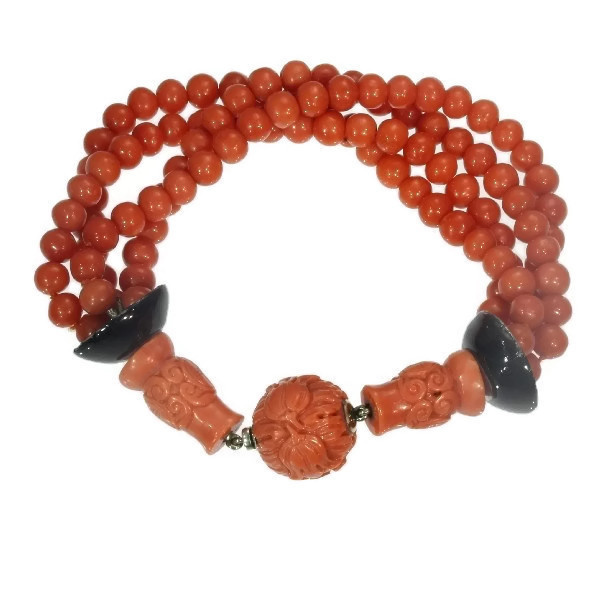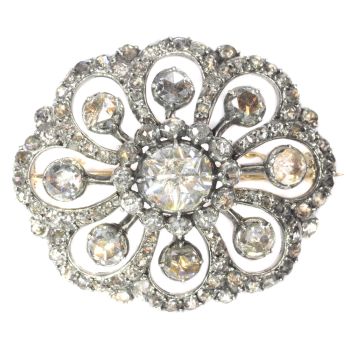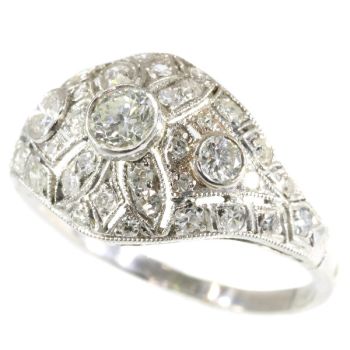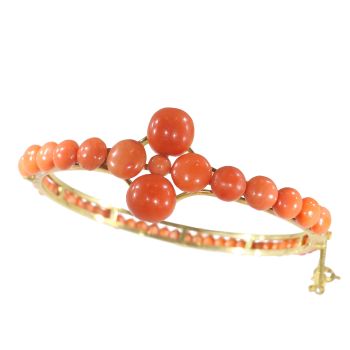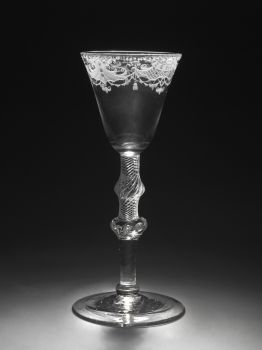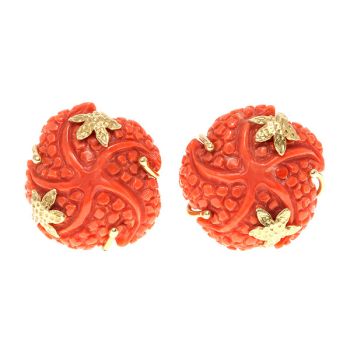Art Deco armband met emaille kralen van koraal, 4 strengen 1920
Onbekende Kunstenaar
Geel GoudKoraalGoudRood koraal
€ 8.500
Adin Fine Antique Jewellery
- Over kunstwerkArt Deco enameled coral beaded bracelet, 4 strands.
This Art Deco bracelet ascends from customary antique jewellery to the level of applied arts due to its rare combination in craftsmanship of goldsmithed 18K yellow gold, of delicately engraved coral beads and of a black enamelled finish. Four coralstrands guide you to a Japanese garden with a central round coral bead with tulip engravings, which disguise the jewel's closure. Two engraved columns followed by black enamelled convex portals guard this gem. Being a strong representative of Japonism in the 1920's, this bracelet is eagerly waiting to serve its next Geisha.
Antique jewelry object group: flexible bracelets/bangles
Country of origin: Although it does not carry any legible control marks we believe this to be of French or Belgian origin.
Style: Art Deco
(more info on styles)
Style specifics: Abstract motives and geometrical forms are quite typical for the Art Deco period.
Period: ca. 1920
(events and facts in 1920)
Source of inspiration: Japan
Theme: Japanese style engravings in the coral
Material: 18K white gold
(more info on precious metals)
Technique: Enamelling is an old and widely-adopted technology. The ancient Egyptians applied enamels to pottery and stone objects. The ancient Greeks, Celts, Russians, and Chinese also used enameling processes on metal objects. Enamel is the colorful result of fusing powdered glass to a substrate by firing, usually between 750 and 850 degrees Celsius. The powder melts and flows and hardens to a smooth, durable vitreous coating on metal, glass or ceramic. According to some sources, the word enamel comes from the High German word smelzan (to smelt) via the Old French esmail. Used as a noun, "an enamel" is a usually smalldecorative object, coated with enamel coating, such as a champlevé or a cloisonné (different techniques).
Extra information: Japonism, or Japonisme, the original French term, which is also used in English, is a term for the influence of the arts of Japan on those of theWest. The word was first used by Jules Claretie in his book L'Art Francais en 1872 published in that year. Works arising from the direct transfer of principles of Japanese art on Western, especially by French artists, are called japonesque.
Precious stones: coral(more info on precious stones):
- Four coral bead strands with 104 corals in total, diameter approx. 6 mm
- Two engraved coral ornaments measuring approx. 17.7 mm by 10.5 mm
- One round shaped engraved coral (the clasp) with a diameter of approx. 16.6 mm
Hallmarks: No trace.
(more info on hallmarks)
Condition: good condition (one of the white gold dishes that are black enameled has some chips off at the edge)
(more info on our condition scale)
Dimensions: length 20.50 cm (8.07 inch)
Weight: 50.00 gram (32.15 dwt)
Reference Nº: 10015-4360
See also our:
bracelets, art deco jewelry, jewelry with enamel, jewelry with coral, latest acquisitions,
antique jewelry, estate jewelry, vintage jewelry or modern jewelry
Jewelry with birthstones (or month stones) for:
January - February - March - April - May - June - July
August - September - October - November or December.
Additional information:
jewelry glossary - wall of fame - visit us in Antwerp - subscribe to our mailinglist.
What is antique jewelry? - What is estate jewelry? - What is vintage jewelry? - Over kunstenaar
Het kan voorkomen dat een kunstenaar of maker onbekend is.
Voor sommige werken is het niet te bepalen door wie het gemaakt is of dat het is gemaakt door (een groep) ambachtslieden. Voorbeelden zijn beelden uit de Oudheid, meubels, spiegels of handtekeningen die vaak niet duidelijk of leesbaar zijn. Maar ook sommige werken zijn helemaal niet gesigneerd.
Ook kunt u de volgende beschrijving vinden:
•"Toegeschreven aan …." waarschijnlijk een werk van de kunstenaar maar niet zeker of gedeeltelijk
•“Atelier van ….” of werkplaats van” een werk uitgevoerd in het atelier of atelier van de kunstenaar, eventueel onder zijn toezicht
•“Cirkel van ….” een werk uit de periode van de kunstenaar die zijn invloed laat zien, nauw verbonden met de kunstenaar maar niet noodzakelijkerwijs zijn leerling
•“Stijl van ….” of “Volger van ….” een werk uitgevoerd in de stijl van de kunstenaar, maar niet noodzakelijk door een leerling; kan eigentijds of bijna eigentijds zijn
•“Wijze van ….” een werk in de stijl van de kunstenaar maar van latere datum
•"Na …." een kopie (van welke datum dan ook) van een werk van de kunstenaar
•“Getekend…”, “Gedateerd….” of “Ingeschreven” dan is het werk gesigneerd/ gedateerd/ ingeschreven door de kunstenaar. De toevoeging van een vraagteken duidt op een element van twijfel
•"Met handtekening ...", "Met datum ...", "Met opschrift..." of “Draagt signatuur/datum/opschrift” dan is de handtekening/datum/opschrift toegevoegd door iemand anders dan de kunstenaar
Bent u geïnteresseerd om dit kunstwerk te kopen?
Artwork details
Related artworks
Onbekende Kunstenaar
The bell of the VOC fortress in Jaffna, Sri Lanka1747
Prijs op aanvraagZebregs & Röell - Fine Art - Antiques
 Gecureerd door
Gecureerd doorDanny Bree
Onbekende Kunstenaar
Oorbellen 18 k wit goud met parelsearly 20th
Prijs op aanvraagDe Zweedse Schatkamer
1 - 4 / 12René Lalique
Een zeer zeldzame diep groene 'Fougeres' vaas ontworpen door R. Lalique1912
€ 8.950Lennart Booij Fine Art and Rare Items
 Gecureerd door
Gecureerd doorSilla Scheepens
1 - 4 / 24Onbekende Kunstenaar
18e-eeuwse diamanten armband met 2000 jaar oude Romeinse intaglio's1790
€ 23.000Adin Fine Antique Jewellery
 Gecureerd door
Gecureerd doorDanny Bree
1 - 4 / 24Gyrinus
Stippen gegraveerd glas met putti1764 - 1766
Prijs op aanvraagPeter Korf de Gidts - Antiquairs
Onbekende Kunstenaar
Een zeldzame filigrana a retortoli bokaal1550 - 1600
Prijs op aanvraagPeter Korf de Gidts - Antiquairs
Onbekende Kunstenaar
Gevleugelde Venetiaanse Beker1624 - 1626
Prijs op aanvraagPeter Korf de Gidts - Antiquairs
1 - 4 / 24- 1 - 4 / 24
- 1 - 4 / 12







